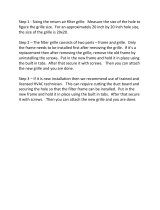Johnson Controls W Series Owner's manual
- Category
- Split-system air conditioners
- Type
- Owner's manual
This manual is also suitable for
The Johnson Controls W Series Cassette Type Indoor Unit is a powerful and efficient air conditioning solution for your home or office. With its 24K BTU capacity, it can cool or heat large rooms quickly and evenly. The unit's sleek and compact design makes it a great choice for any décor, and its quiet operation won't disturb your peace. The W Series also comes with a variety of features to make your life easier, including a remote control, a programmable timer, and a sleep mode.
The Johnson Controls W Series Cassette Type Indoor Unit is a powerful and efficient air conditioning solution for your home or office. With its 24K BTU capacity, it can cool or heat large rooms quickly and evenly. The unit's sleek and compact design makes it a great choice for any décor, and its quiet operation won't disturb your peace. The W Series also comes with a variety of features to make your life easier, including a remote control, a programmable timer, and a sleep mode.




















-
 1
1
-
 2
2
-
 3
3
-
 4
4
-
 5
5
-
 6
6
-
 7
7
-
 8
8
-
 9
9
-
 10
10
-
 11
11
-
 12
12
-
 13
13
-
 14
14
-
 15
15
-
 16
16
-
 17
17
-
 18
18
-
 19
19
-
 20
20
-
 21
21
-
 22
22
-
 23
23
-
 24
24
-
 25
25
-
 26
26
-
 27
27
-
 28
28
Johnson Controls W Series Owner's manual
- Category
- Split-system air conditioners
- Type
- Owner's manual
- This manual is also suitable for
The Johnson Controls W Series Cassette Type Indoor Unit is a powerful and efficient air conditioning solution for your home or office. With its 24K BTU capacity, it can cool or heat large rooms quickly and evenly. The unit's sleek and compact design makes it a great choice for any décor, and its quiet operation won't disturb your peace. The W Series also comes with a variety of features to make your life easier, including a remote control, a programmable timer, and a sleep mode.
Ask a question and I''ll find the answer in the document
Finding information in a document is now easier with AI
Related papers
-
Johnson Controls DHMW09NCB21S Owner's manual
-
York DHR18NCB21S Installation guide
-
Johnson Controls M Series Multi Zone System Installation guide
-
York DCX12CSB11S Installation guide
-
Johnson Controls DHW18CMB21S User manual
-
York DHR18NCB21S User manual
-
Johnson Controls DHY12CSB21S Installation guide
-
Johnson Controls P-Series Single Zone System Installation guide
-
Johnson Controls Z Series Installation guide
-
Johnson Controls P-Series Single Zone System User manual
Other documents
-
York W-Series Multi Zone System Installation guide
-
York W-Series Multi Zone System Installation guide
-
York P-Series Single Zone System Installation guide
-
York W-Series Multi Zone System Installation guide
-
York 23 SEER Single-Zone System X-Series Installation guide
-
York P-Series Single Zone System Installation guide
-
York 23 SEER Single-Zone System X-Series Installation guide
-
 Venti Air HFG1212 Operating instructions
Venti Air HFG1212 Operating instructions
-
York P-Series Single Zone System User manual
-
York P-Series Single Zone System User manual




























